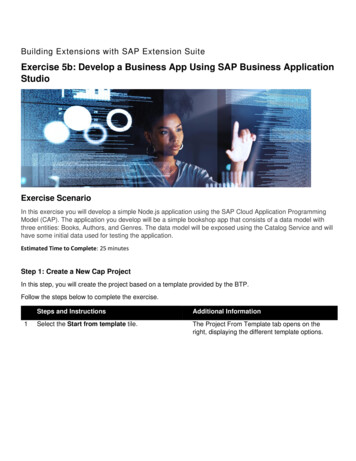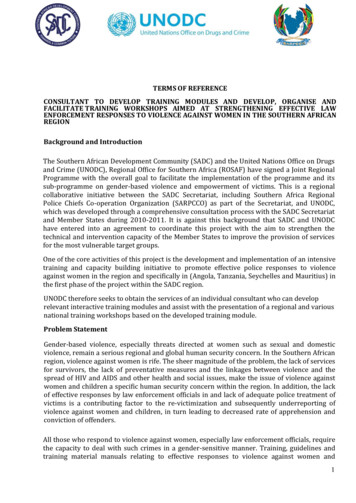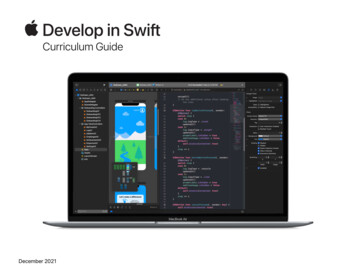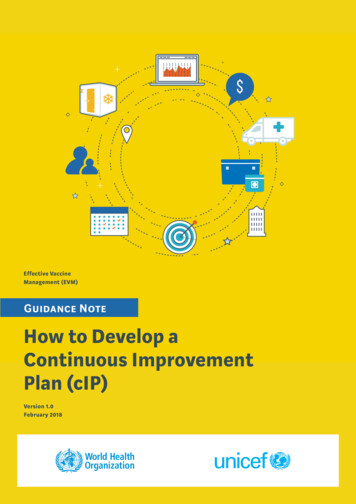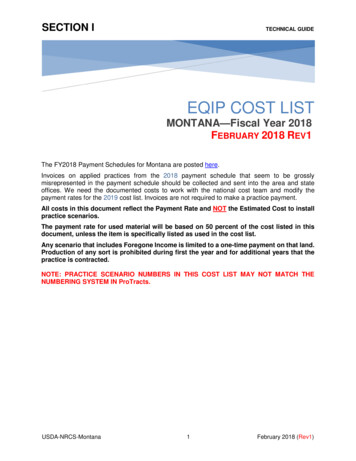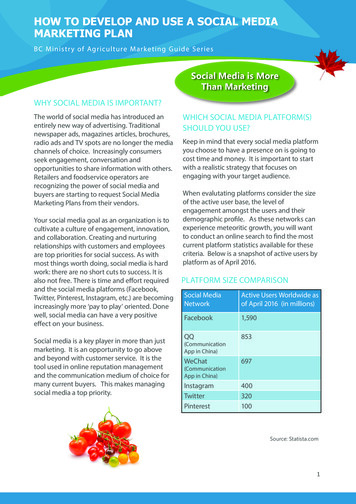
Transcription
HOW TO DEVELOP AND USE A SOCIAL MEDIAMARKETING PLANBC Minis tr y of Agriculture Marketing Guide SeriesSocial Media is MoreThan MarketingWHY SOCIAL MEDIA IS IMPORTANT?The world of social media has introduced anentirely new way of advertising. Traditionalnewspaper ads, magazines articles, brochures,radio ads and TV spots are no longer the mediachannels of choice. Increasingly consumersseek engagement, conversation andopportunities to share information with others.Retailers and foodservice operators arerecognizing the power of social media andbuyers are starting to request Social MediaMarketing Plans from their vendors.Your social media goal as an organization is tocultivate a culture of engagement, innovation,and collaboration. Creating and nurturingrelationships with customers and employeesare top priorities for social success. As withmost things worth doing, social media is hardwork: there are no short cuts to success. It isalso not free. There is time and effort requiredand the social media platforms (Facebook,Twitter, Pinterest, Instagram, etc.) are becomingincreasingly more ‘pay to play’ oriented. Donewell, social media can have a very positiveeffect on your business.Social media is a key player in more than justmarketing. It is an opportunity to go aboveand beyond with customer service. It is thetool used in online reputation managementand the communication medium of choice formany current buyers. This makes managingsocial media a top priority.WHICH SOCIAL MEDIA PLATFORM(S)SHOULD YOU USE?Keep in mind that every social media platformyou choose to have a presence on is going tocost time and money. It is important to startwith a realistic strategy that focuses onengaging with your target audience.When evalutating platforms consider the sizeof the active user base, the level ofengagement amongst the users and theirdemographic profile. As these networks canexperience meteoritic growth, you will wantto conduct an online search to find the mostcurrent platform statistics available for thesecriteria. Below is a snapshot of active users byplatform as of April 2016.PLATFORM SIZE COMPARISONSocial MediaNetworkActive Users Worldwide asof April 2016 (in erPinterest400320100(CommunicationApp in China)(CommunicationApp in China)Source: Statista.com1
HOW TO DEVELOP AND USE A SOCIAL MEDIAMARKETING PLANBC Minis tr y of Agriculture Marketing Guide SeriesSocial MediaRequires Time and EffortDEMOGRAPHICS AND ENGAGEMENTMost social media networks provideopportunity to reach almost all audiencesacross all channels. However, there are still afew channels that are dominated by aparticular demographic such as Instragram bythe 16-24 year old group.Engagement or interaction rates across socialnetworks also vary. You may find thatSnapchat is best for engaging Millenials or thatFacebook is better suited to interacting with35-55 year old females. The key is to find thenetwork where your target audience spendstheir time.A few of things to consider:1. ‘Hang out’ where your audience ishanging out.Evaluate your current social media accountsand keep what is working. Review your topcompetitor’s social media profiles. Who arethey talking to? Are they getting theengagement that you wish your company had?Ask your customers. Which social mediachannels would they prefer you to use?2. Do what you love.Pick a social media channel you like to ‘hangout’ on and for which you find it relatively easyto produce content. Do not make YouTube themain company social media presence if makingvideos is not something you love to do anddo well. You are going to be spending a lot oftime in the channel(s) you choose, so choosewisely.3. Delegate.What can you delegate? Social media is hardwork. Daily posts, weekly blogs and otheractivities require time and effort that you maynot have. Consider who on the team canassist with managing the company’s socialmedia voice or if necessary hire a social mediaconsultant.A solid marketing plan with clear definitionsaround your target audience and goals isfundamental to successfully hiring out yoursocial media. Remember, they will be acting asthe voice of the company online.Tip“Hang out” where youraudience is hanging out.GETTING STARTEDDeveloping a social media marketing planprovides a company with the process neededto align the social media goals with the overallbusiness goals. Before beginning, review thecurrent business strategy to be clear on: whatthe company goals are; who the audience is;and what success looks like. Knowing theoverall company vision will ensure that thesocial media marketing plan stays focused andon track.The following four step process outlines howto develop a social media marketing plan:1.2.3.4.Define Your Goals.Conduct an Audit.Build a Calendar.Measure, Adjust, Repeat.2
HOW TO DEVELOP AND USE A SOCIAL MEDIAMARKETING PLANBC Minis tr y of Agriculture Marketing Guide SeriesAlign Social MediaTip withBusiness Goals1. DEFINE YOUR GOALSSocial media goals should follow the S.M.A.R.T.approach and be SPECIFIC, MEASURABLE,ACHIEVABLE, RELEVANT and TIMELY.SPECIFIC - What do you hope to accomplish?Every company approaches social mediadifferently. The goal might be to buildfollowers or drive traffic to a website. Ensureyour social media goals are aligned with corebusiness goals and base them around traffic,leads and sales not just metrics such as ‘Likes’and ‘Retweets’.Some examples are: Increase engagement on Facebook by 5%Convert 25% of prospects into salesGrow Twitter followers by 20%Increase conversion rates by 5%MEASURABLE - What does success look like?How is it measured?Examples of quantifiable goals are: ‘shares’(# of times a post is shared by anotherindividual), ‘post reach’ (# of unique peoplewho saw your content) and ‘page impressions’(# of times a post from your page is displayed)in Facebook; or ‘mentions’ (anytime a Tweetcontains your @username in the body of theTweet) or ‘followers’ (# of people who receiveyour Tweets) in Twitter.Begin by writing down the steps needed toachieve the desired goal.For example: If your objective is to get 1,000new Facebook followers in six months, amilestone might be to achieve 166 newfollowers a month. Evaluate your progress atthe end of each month. If after two months,you have only achieved 50 new followers,re-evaluate and make adjustments to yourtactics. Be careful not to make hasty decisions.A reasonable rule of thumb to follow is toevaluate weekly but only take tactical actiononce a month.If your Facebook followers have not grownat the desired rate, then evaluate the currentplan. Right now you have your team postingone photo 5 days/week between 9am - 11am,following two new Facebook pages andsharing two posts each day.What can you do? Given that the goal is togrow followers, it makes sense to increase thenumber of people or pages followed from twoper day to 5-10 per day. Share at least twoposts from each new follower and focus onbuilding relationships by searching forFacebook people and pages that are interestedin like-minded topics and are likely to followyou back.This is an example of just one tactical changethat could be made to get you closer toachieving 1,000 new followers.3
HOW TO DEVELOP AND USE A SOCIAL MEDIAMARKETING PLANBC Minis tr y of Agriculture Marketing Guide SeriesSocial Media is theCompany’s VoiceACHIEVABLE - Is the goal possible?Keep your objectives within the realm of thepossible. It might be a company dream to have100,000 followers on Facebook by the end ofthe year, but is it attainable?Checking your past performance willquickly reveal recent growth rates and indicateif achieving 100,000 followers is possible or ifperhaps a target of 10,000 followers is morefeasible.RELEVANT AND REALISTIC - Is the goalrealistic?Does the company have the time andresources necessary? Does the goal fit thecurrent company situation? This is a goodplace to note any possible obstacles that mightcome up and prevent you from achieving thegoal.TIMELY - What is the time frame for this goal?Determine when success metrics will bemeasured right from the start. This will enableregular and timely decisions to be made.Give your team enough time to achieve thegoal by setting a date and not working towards‘someday’.S.M.A.R.T. ExampleAssume that you want to increase your brand awareness on Facebook because you have identified it as anexcellent channel to connect with your target audience.SPECIFICAsk the right questions. Who? What? Why? “We will grow our Facebook followers toinspire our target audience with lifestyle and recipe options that promote GoWildsalmon jerky.”MEASURABLEOur target follower base is 5,000.ATTAINABLEBased on our current growth rate of 200 followers per month, this is achievable.RELEVANTFacebook is an active community of 35-55 year old females intereseted in lifestyle,travel and food. GoWild salmon jerky is a healthy (lifestyle), travel friendly food.TIMELYDeadline is December 2017.GOAL“We will grow the GoWild Facebook page from 1,000 followers to 5,000 followers byDecember 31, 2017.”4
HOW TO DEVELOP AND USE A SOCIAL MEDIAMARKETING PLANBC Minis tr y of Agriculture Marketing Guide SeriesBaseline Data is Key toMeasuring Success2. CONDUCT AN AUDITEstablishing a baseline of where your companycurrently is in social media is fundamental tomeasuring future success. Review all companyprofiles. Get to know the audiences on each,the engagement levels, and the posts thatworked. Here’s how:Identify Top PerformersAfter reviewing all of the company’s socialmedia channels, it should be obvious which areperforming better than others. Once you havefound the top channels, dig deeper and findthe posts that receive the most engagement.Create A TemplateWhen you know what type of postsconsistently generate impact with yourfollowers, look for any patterns around thetiming of those top posts. This will give youa clear picture of the type of post that worksbest for each social media channel. Then it is amatter of creating more of that type of contentfor your content calendar which is discussed ina following section.Build a simple spreadsheet, or use an onlinetemplate to track the following: Profile information (name and URL); Posting frequency; Follower count; Referral traffic; and Channel specific metrics.Compare Percentage ChangeYou will want to have a column to measure thepercentage change month over month andyear over year. Comparing December data toNovember data is less meaningful thancomparing December of the current year toDecember of the previous year.TipMeasure year overyear not just monthover month.Not all social media channels use the samemetrics so you will likely require a differenttemplate for each. For example, there is nopoint in tracking ‘Retweets’ in Facebook.5
HOW TO DEVELOP AND USE A SOCIAL MEDIAMARKETING PLANBC Minis tr y of Agriculture Marketing Guide SeriesCompany GoalsTip KeepFront and Centre3.BUILD A CONTENT CALENDARA content calendar is a tool to organize variousforms of content such as videos, blogs,infographics and apply a schedule to thedelivery of these media forms. It is a planningdocument that helps your team actdeliberately and intentionally whenconnecting with your audience.When thinking about how to organize yourcontent calendar ask yourself what yourbusiness is trying to achieve. The answer tothis question will lay the groundwork for yourcontent calendar. Your goal may be to increaseleads, build brand awareness or improve yoursearch engine rankings. The content calendarwill help you organize what needs to be doneevery month to achieve your goals.When you have your content planned, it givesyou an opportunity to review what was donein the past, analyze how successful it was andidentify new content ideas for the future.It is a single focus point for the entire teamthat works to keep everyone up to date and onmessage.Content calendars are an excellent tool forcollaboration. Invite your team to brainstormideas, contribute articles and assign tasks.SAMPLE CALENDAR LAYOUTTitleAuthor TopicDeadline Time ImagesChannelsMondayEasy WeekdayJoan S. 5 ways to use GoWild12/8/20166:00 Screenshot A Blog, Facebook, Twit-Increased Produc- Joan S. Press Release - New12/8/20169:00 new-facility.jpgTwitter, LinkedInTuesdayCalendar template courtesy of Hootsuite6
HOW TO DEVELOP AND USE A SOCIAL MEDIAMARKETING PLANBC Minis tr y of Agriculture Marketing Guide SeriesTipMeasureSales, Influence,MomentumTHINGS TO KEEP IN MIND Keep the company goals front and centre.It is easy to get side tracked in social media. Understand what your customer wantsand give it to them in manageable pieces.Think about your popular posts and buildvariations. Allow room to experiment withnew styles of posts as you grow youraudience. You never know what mightresonate. Know your audience profile. Determine how often you will post. Decide who on your team will beresponsible. Evaluate the company’s assets ofimages and graphics. Social media is avisual medium. Having a strong repositoryof top quality images, graphics and/orvideo will go a long way towards asuccessful social media presence. Ifimages, graphics and videos are notcurrently part of the company asset list,build in time and budget to make ithappen.RESEARCH WHICH HASHTAGS TO USEHashtags are part of almost every social mediachannel. Learning how to use them effectivelycan boost your social media effortssignificantly. They categorize your content,offer an opportunity to brand your companyand specific campaigns, as well as make yourcontent more easily discoverable by peopleinterested in like-minded topics.Keep an eye on which hashtags are part of yourmost popular posts and note which ones yourcompetitors are using successfully.Sample Tweet:14g of protein, 12g of carbs, Mother Nature’scandy - #GoWild #SalmonJerky #BuyLocal7
HOW TO DEVELOP AND USE A SOCIAL MEDIAMARKETING PLANBC Minis tr y of Agriculture Marketing Guide SeriesTipMeasureSales, Influence,Momentum4. MEASURE, ADJUST, REPEATMeasuring the impact of social media is notas simple as measuring a direct sale althoughthat can be one aspect of it. Depending onthe goals you started with, you might also bemeasuring indirect sales such as influence aswell as momentum.You might choose to use a combination offree and paid tools. Google Analytics is afree tool that does a good job of identifyingtraffic sources and tracking conversions. Youwill have to install some tracking code in yoursocial links to do this but it is worth the effort,and can be done with Google’s URL Builder.Each social media platform will have its ownform of analytics or tracking just as it will haveits own metrics. Compare the data with whatyou expected. Look at industry benchmarks,other campaigns and competitors. How areyou doing? The key is to measure regularly andto review your data in context. Look for trends,not just absolute numbers so that as thecompany’s influence grows and you seeevidence in increased indirect conversions andmomentum, you can adjust tactics accordingly.If you are not sure which analytics to use tomeasure which social media channel, do aquick Google search, read the reviews or askaround. There are plenty of options available.Be aware that not all measurement optionskeep data forever or have the same reportingcapabilities.Some examples are:Google Analytics – Free tool that trackswebsite, social media and other marketinginitiatives with the use of tracking code.Facebook Insights – Free analytics built intoevery Facebook account. You must have 30likes to access it.Twitter Analytics – Sign up for Twitter cardsor become an advertiser.Pinterest Analytics – Available with abusiness account.Instagram Analytics – Available withbusiness profile.MORE INFORMATIONSee the Ministry of Agriculture’s Marketing Guide Series for more information and additional topics byvisiting tatisticsThe Government of Canada, the BC Ministry of Agriculture, and its directors, agents, employees, or contractors will not be liablefor any claims, damages, or losses of any kind whatsoever arising out of the use of, or reliance upon, this information.8
BC Ministry of Agriculture Marketing Guide Series HO TO DEVELOP AND USE A SOCIAL MEDIA MARKETING PLAN Social Media Requires Time and Effort Tip "Hang out" where your audience is hanging out. 2 Developing a social media marketing plan provides a company with the process needed to align the social media goals with the overall business goals.


